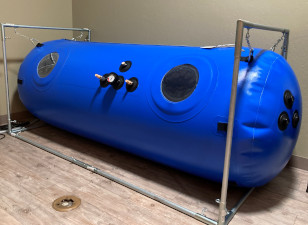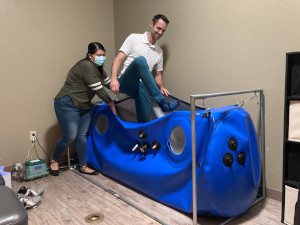
Chiropractor Chandler AZ
Hyperbaric Oxygen Therapy for Sports Injury Recovery
Hyperbaric oxygen treatments are a non-invasive therapeutic approach to resolving a variety of acute and chronic conditions including decompression sickness, carbon monoxide poisoning and necrotic tissue injury. Although it has yet to be granted FDA approval, a growing number of elite athletes including LeBron James, Michael Phelps, Rafael Soriano and Rashad Jennings have used hyperbaric treatments to hasten recovery from sports injuries (Aspire, n,d,). For these individuals, extended rehabilitation following an injury can mean a significant loss of income; hence the search for therapeutic modalities to speed recovery.
What is the science behind the treatment?
Fundamentally, hyperbaric oxygen therapy delivers an oxygen-enriched atmosphere to the body through two mechanisms: atmospheric compression (greater than sea level), and utilization of pure oxygen. Together, these factors enable blood plasma to absorb significantly more oxygen than it would breathing ambient air. As such, the body no longer needs to depend on oxygen bound to hemoglobin to heal (Barata et al., 2011).

Muscle strains which typically involve micro-tears in muscle tissue are the most common sports-related injuries among both professional and recreational athletes (Oyaizu et al., 2018). In order to heal, these acute injuries progress through inflammation, proliferation and maturation phases. Hyperbaric oxygen therapy (HBOT) hastens the transition from inflammation to proliferation via vasoconstriction that reduces edema and by increasing the rate and amount of proliferation of satellite cells. Satellite cells function similar to stem cells in the muscle tissue, differentiating into myoblasts that produce new healthy tissue (Oyaizu et al., 2018).
Extended HBOT treatments produce free radicals of oxygen and nitrogen that activate cellular messaging via vascular endothelial growth factor (VEGF) and hypoxia-inducible factor 1-alpha to speed up the healing process (Moghadam et al., 2019). At the same time, it reduces neutrophil adhesion at the injury site and mitigates ischemia reperfusion injury (Moghadam et al., 2019). As a result, the healing process is cleaner, with less scar tissue, improved microvascular structure and better quality collagen to return the muscle to its pre-injury tensile strength (Moghadam et al., 2019).

Although studies on human subjects have been limited for ethical reasons, there have been a number of animal studies documenting these physiological effects. Notable is a rodent model developed by Oyaizu and colleagues, to study the effects of HBOT on contused calf muscles (Oyaizu et al., 2018). Researchers utilized about 400 animals for the study, separating those with surgically induced calf injuries into treatment and control groups. The treatment group received short HBOT treatments in a specially designed chamber for five consecutive days.
Researchers documented that the treatment group’s injuries exhibited dramatically reduced hypoxia (oxygen starvation) that lasted up to 30 hours after a single session (Oyaizu et al., 2018). As a result, these animals suffered from significantly less swelling on the injured leg. After transition to the proliferation phase, IL-6 (an inflammatory cytokine) and STAT3 (a downstream protein) increased both the speed and number of satellite cells that developed in the injured areas, to improve regeneration of muscle fibers and restore muscle strength (Oyaizu et al., 2018). These results were statistically significant, providing a scientific basis for converging anecdotal evidence in human subjects.
Hyperbaric oxygen therapy protocol
There are two types of hyperbaric chambers: large multiplace chambers that hold eight patients and an overseer, and monoplace chambers that hold a single patient (Schaefer, 1992). The former are more common in tertiary care facilities (hospitals), while most outpatient clinics use the single chambers (Tibbles & Edelsberg, 1996). Physicians have determined that treatments lasting up to two hours at pressures up to 3 atmospheres are safe and effective (Tibbles & Edelsberg, 1996). A typical treatment lasts between 45 and 90 minutes, not including 15 minutes to pressurize the chamber at the start and 15 to depressurize at the end (Schaefer, 1992).
Similar to being on an airplane, some patients may feel pressure inside of their ear canals during pressurization and depressurization. Clearing the ears should prevent any discomfort. The machine makes some noise, but most individuals are comfortable reading and relaxing inside the chamber. An intercom enables the person inside the chamber to communicate with his or her provider.
References
Aspire Regenerative (n.d.). Five athletes who use hyperbaric therapy during training. http://www.aspireregenerativehealth.com/5-athletes-who-use-hyperbaric-therapy-during-training
Barata, P. et al. (2011). Hyperbaric oxygen effects on sports injuries. Therapeutic Advances in Musculoskeletal Disease, 3(2), 111-121. https://doi.org/10.1177/1759720X11399172
Moghadam, N. et al. (2020). Hyperbaric oxygen therapy in sports musculoskeletal injuries. Medicine & Science in Sports & Exercise (American College of Sports Medicine). http://www.acsm-msse.org
Oyaizu, T. et al. (2018). Hyperbaric oxygen reduces inflammation, oxygenates injured muscle, and regenerates skeletal muscle via macrophage and satellite cell activation. Scientific Reports, 8, 1288. https://www.doi.org/10.1038/s41598-018-19670-x
Schaefer, S. (1992). Fundamentals of hyperbaric oxygen therapy. Orthopaedic Nursing, 11(6), 9-15.
Tibbles, P. & Edelsberg, J. (1996). Hyperbaric oxygen therapy. New England Journal of Medicine, 334(5), 1642-1648.